Japanese national holidays
The following are Japanese national holidays [国民の祝日 or shorter 祝日] and some of the most important other annual nationwide events. In addition, there are countless local annual festivals. If a national holiday falls on a Sunday, the following Monday will also be a holiday. If a day lies between two national holidays, the day will also be turned into a holiday.
January 1 (national holiday)
New Year (元日 shogatsu):

New Year (元日 shogatsu or 四方節 oshogatsu) is the most important holiday in Japan. Most businesses shut down from January 1 to January 3, and families typically gather to spend the days together.
Years are traditionally viewed as completely separate, with each new year providing a fresh start. Consequently, all duties are supposed to be completed by the end of the year, while bonenkai parties ("year forgetting parties") are held with the purpose of leaving the old year's worries and troubles behind.
Homes and entrance gates are decorated with ornaments made of pine, bamboo and plum trees, and clothes and houses are cleaned.
On New Year's eve, toshikoshi soba (buckwheat noodles), symbolizing longevity, are served. A more recent custom is watching the music show "kohaku uta gassen", a highly popular television program featuring many of Japan's most famous J-pop and enka singers in spectacular performances.
January 1 is a very auspicious day, best started by viewing the new year's first sunrise (hatsu-hinode), and traditionally believed to be representative for the whole year that has just commenced. Therefore, the day is supposed be full of joy and free of stress and anger, while everything should be clean and no work should be done.
It is a tradition to visit a shrine or temple during shogatsu (hatsumode). The most popular temples and shrines, such as Tokyo's Meiji Shrine, attract several million people during the three days. Most impressive are such visits at the actual turn of the year, when large temple bells are rung at midnight.
Various kinds of special dishes are served during shogatsu. They include osechi ryori, otoso (sweetened rice wine) and ozoni (a soup with mochi).
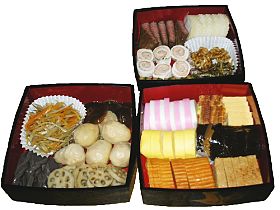 | 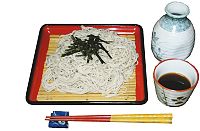 |
There are also a few games traditionally played on New Year, however, their popularity has decreased in recent times. Hanetsuki (Japanese badminton), takoage (kite flying), and karuta (a card game) are some of them.
A very popular custom is the sending of New Year's cards, which are specially marked to be delivered on January 1. It is not uncommon for one person to send out several dozens of cards to friends, relatives and co-workers.
Second Monday of January
(national holiday)
Coming of Age (成人の日 seijin no hi):
The Coming of Age festival is celebrated on the second Monday of January (it used to be celebrated always on January 15 until the year 1999). Its Japanese name is Seijin no hi. All young people who turn twenty years old in that year are celebrated on Seijin no hi. Twenty is the age considered as the beginning of adulthood. It is also the minimum legal age for voting, drinking, and smoking.
Celebrations are held nationwide in every town with most of the people turning 20 participating in formal dresses.
February 3
Beginning of spring (節分 setsubun):
Setsubun ("seasonal division") is a festival held on February 3 or 4, one day before the start of spring according to the Japanese lunar calendar. Setsubun is not a national holiday.
For many centuries, the people of Japan have been performing rituals with the purpose of chasing away evil spirits at the start of spring.
Around the 13th century, for example, it became a custom to drive away evil spirits by the strong smell of burning dried sardine heads, the smoke of burning wood and the noise of drums. While this custom is not popular anymore, a few people still decorate their house entrances with fish heads and holy tree leaves in order to deter evil spirits from entering.
In modern days, the most commonly performed setsubun ritual is the throwing of roasted beans (豆撒き) around one's house and at temples and shrines across the country. When throwing the beans, you are supposed to shout "Oni wa soto! Fuku wa uchi!" ("Devils out, happiness in"). Afterwards you should pick up and eat the number of beans, which corresponds to your age.
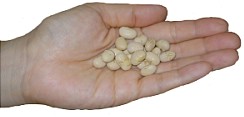
As all traditional festivals, setsubun is celebrated in many variations throughout the country.
February 11 (national holiday)
National Foundation Day
(建国記念の日 kenkoku kinenbi):
According to the earliest Japanese history records, on this day in the year 660 BC the first Japanese emperor was crowned.
February 14
Valentine's Day:
In Japan, women give chocolates to men on Valentine's Day. It is not a national holiday.
| Survey Results |
|---|
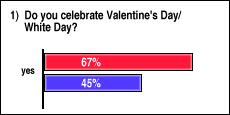 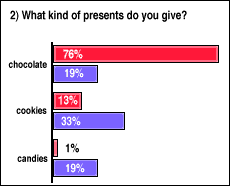 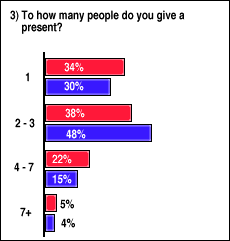 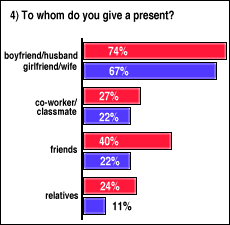 |
| In the graphics below, the red color refers to women and Valentine's Day while the blue color refers to men and White Day. |
Valentine's Day
and White Day
In February 2000, we sent questionnaires to 2700 people who were registered in the category of Japan of our pen pal service and who indicated that they are willing to participate in surveys. We received 269 valid responses from Japanese people who live in Japan; 77% of them were female, 85% single, and 71% below 30 years young. In addition to the unbalance in age, marital status and gender, we must consider the fact that all survey participants are registered in an online international pen pal service, which may mean that they are overall more internationally and less traditionally oriented than the average Japanese.
St. Valentine's Day is celebrated on February 14, and White Day one month later on March 14. It is said that St. Valentine's Day was imported to Japan in 1958 by a Japanese confectionery company. In Japan, it is only the women giving presents - mainly chocolate - to men, but not the other way around. Men are supposed to return the favours received on Valentine's Day one month later on White Day, a Japanese creation. White Day is believed to have been introduced by a marshmallow manufacturing company in the 1960s. The white marshmallows gave the day its name but other kinds of presents such as candy, flowers, etc. have become more popular over the years.
According to our survey, White Day is still less popular than St. Valentine's Day. 67% of the female survey participants indicated that they do celebrate Valentine's Day while only 45% of the men indicated to celebrate White Day. The two events are most popular among participants younger than 20 years with 75% celebrating Valentine's Day and 56% celebrating White Day. Valentine's Day is also more popular among single people than married couples, however, White Day is clearly more popular among married people (51%) than singles (40%). In fact, among married couples, White Day (51.3%) is almost as popular as Valentine's Day (53.9%).
As expected, the most popular Valentine's present is chocolate with over three forth of all women (who celebrate Valentine's Day) following this tradition. One third of the women celebrating Valentine's Day give a present to just one person. Another third gives presents to two to three persons, while the rest (27%) gives presents to more than three. Three out of four women give presents to their boyfriends or husbands, 40% to other friends, 27% to co-workers or classmates, and 24% to relatives.
On White Day, on the other hand, there seems to be a much greater variety of presents. 33% of the men celebrating White Day give cookies as presents. Only 11% give flowers. 55% make presents other than cookies, sweets or flowers. Almost half of the men give presents to two to three women and 29% to just one. The rest (19%) gives presents to more than three women. Two thirds of the men celebrating White Day give presents to their girlfriends or wives. Less than one out of four give presents to co-workers and/or friends. Only one out of ten make presents to relatives.
March 3
Doll's Festival (雛祭 hina matsuri):
Also called girl's festival.
The Hina Matsuri or Doll Festival or Girl's Festival is celebrated on March 3. On this day, families with girls wish their daughters a successful and happy life. Dolls are displayed in the house together with peach blossoms. The doll festival has its origin in a Chinese custom in which bad fortune is transferred to dolls and then removed by abandoning the doll on a river. On Hina Matsuri, sweet sake is drunken and chirashi sushi is eaten.
March 14
White Day (ホワイトデー):
The opposite of Valentine's Day: Men give cakes or chocolates to women. It is not a national holiday. (see Valentine's Day February 14)
March 21 (national holiday)
Spring Equinox Day
(春分の日 shunbun no hi):
Graves are visited during the week (ohigan) of the Equinox Day.
Golden Week (黄金週間)
The Golden Week is a collection of four national holidays within seven days. In combination with well placed weekends, the Golden Week becomes one of Japan's three busiest holiday seasons, besides New Year and the Obon week.
Trains, airports and sightseeing spots get very crowded during Golden Week, and accommodation in tourist areas can get booked out well in advance.
- April 29 Showa Day (昭和の日 Showa no hi)
- May 3 Constitution Day (憲法記念日 Kenpo kinenbi)
- May 4 Greenery Day (国民の休日 Midori no hi)
- May 5 Children's Day (子供の日 Kodomo no hi)
April 29 (national holiday)
Showa Day (昭和の日 Showa no hi):
April 29 is the former birthday of Emperor Showa, who died in the year 1989. Until 2006, Greenery Day (see May 4) used to be celebrated on this day.
May 3 (national holiday)
Constitution Day
(憲法記念日 kenpo kinenbi):
On this day in 1947, the new post war constitution was put into effect.
May 4 (national holiday)
Greenery Day (国民の休日 midori no hi):
Until 2006, Greenery Day used to be celebrated on April 29, the birthday of former Emperor Showa. The day is dedicated to the environment and nature, because the emperor loved plants and nature. Before being declared Greenery Day, May 4 used to be a national holiday due to a law, which declares a day, that falls between two national holidays, a national holiday.
May 5 (national holiday)
Children's Day
(子供の日 kodomo no hi or こどもの日):
Also called Boy's Festival. Families pray for the health and future success of their sons by hanging up carp streamers and displaying samurai dolls, both symbolizing strength, power and success in life. (The Girl's Festival, by the way, is celebrated on March 3.)
July/August 7
Star Festival (七夕 tanabata):
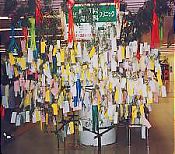
Tanabata is a festival rather than a national holiday.
Tanabata, also known as the "star festival", takes place on the 7th day of the 7th month of the year, when, according to a Chinese legend, the two stars Altair and Vega, which are usually separated from each other by the milky way, are able to meet.
Because the 7th month of the year roughly coincides with August rather than July according to the formerly used lunar calendar, Tanabata is still celebrated on August 7th in some regions of Japan, while it is celebrated on July 7th in other regions.
One popular Tanabata custom is to write one's wishes on a piece of paper, and hang that piece of paper on a specially erected bamboo tree, in the hope that the wishes become true.
Colorful Tanabata festivals are held across Japan in early July and August. Among the biggest and most famous ones are the Tanabata Festivals of Sendai in August and Hiratsuka near Tokyo in July.
Third Monday of July (national holiday)
Ocean Day (海の日 umi no hi):
A recently introduced national holiday to celebrate the ocean. The day marks the return of Emperor Meiji from a boat trip to Hokkaido in 1876.
July/August 13-15
Obon festival (盆):
Obon is an annual Buddhist event for commemorating one's ancestors. It is believed that each year during obon, the ancestors' spirits return to this world in order to visit their relatives.
Traditionally, lanterns are hang in front of houses to guide the ancestors' spirits, obon dances (bon odori) are performed, graves are visited and food offerings are made at house altars and temples.
At the end of Obon, floating lanterns are put into rivers, lakes and seas in order to guide the spirits back into their world. The customs followed vary strongly from region to region.
Obon is celebrated from the 13th to the 15th day of the 7th month of the year, which is July according to the solar calendar. However, since the 7th month of the year roughly coincides with August rather than July according to the formerly used lunar calendar, Obon is still celebrated in mid August in many regions of Japan, while it is celebrated in mid July in other regions.
The Obon week in mid August is one of Japan's three major holiday seasons, accompanied by intensive domestic and international travel activities and increased accommodation rates.
In 2007, the peak of the Obon travel season is anticipated to take place between August 11 and 15.
Third Monday of September
(national holiday)
Respect for the Aged Day
(敬老の日 keiro no hi):
Respect for the elderly and longlivity is celebrated on this national holiday.
September 23 (national holiday)
Autum Equinox Day
(秋分の日 shubun no hi):
Graves are visited during the week (ohigan) of the Equinox Day.
Second Monday of October
(national holiday)
Health and Sports Day
(体育の日 taiiku no hi):
On that day 1964, the Olympic games of Tokyo were opened.
November 3 (national holiday)
Culture Day (文化の日 bunka no hi):
A day for promotion of culture and the love for freedom and peace. On the culture day, schools and the government award certain persons for their special, cultural activities.
November 15
Seven-Five-Three (七五三 shichigosan):
A festival for children, Shichigosan is not a national holiday.
"Shichi Go San" means "Seven Five Three". Girls of age three and seven and boys of age three and five are celebrated on Shichigosan, and it is prayed for their good health and growth. Shichigosan takes place on November 15 and is not a national holiday. On November 15 or the closest weekend, the young people visit a Shinto Shrine dressed up in kimono.
Odd numbers are considered lucky numbers. Long candies in bags that are decorated with turtles and cranes are given to the children. The candy, the crane, and the turtle, all symbolize longlivity.
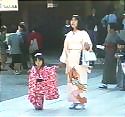 | 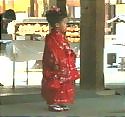 | 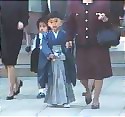 |
| Shichi go san celebrations at Meiji Shrine | ||
November 23 (national holiday)
Labour Thanksgiving Day
(勤労感謝の日 kinro kansha no hi):
A national holiday for honoring labour.
December 23 (national holiday)
Emperor's Birthday
(天皇誕生日 tenno no tanjobi):
The birthday of the current emperor is always a national holiday. If the emperor changes, the national holiday changes to the birthday date of the new emperor.
December 24-25
Christmas:
Christmas is not a national holiday, but it is celebrated by an increasing number of Japanese.
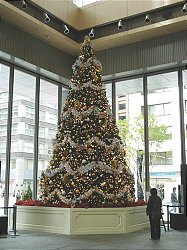
Christmas was initially introduced to Japan with the arrival of the first Europeans in the 16th century. But only in recent decades has the event become widely popular in Japan, and this despite the fact that Christians make up only about two percent of the population.
While christmas is not a national holiday in Japan, more and more people are taking up traditions such as decorating their home, giving presents to friends and celebrating the event with a special meal.
In a survey conducted by japan-guide.com among young Japanese people, a majority of 54 percent responded that christmas means something special to them, with women and teenagers showing a particular attraction.
Most enthusiastic about christmas, however, seem to be retail stores and shopping malls, where christmas trees, santa clauses and other seasonal decorations can be found several weeks in advance. Some public places also feature seasonal illuminations.
The traditional Japanese christmas food is the christmas cake, usually made of sponge cake, strawberries and whipped cream. In our survey, as many as 73 percent responded to celebrate christmas with a cake.
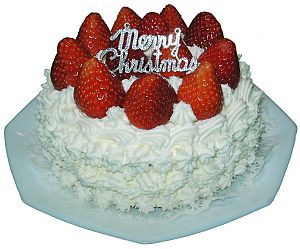
December 31
New Year's Eve (大晦日 omisoka):
December 31 is not a national holiday.